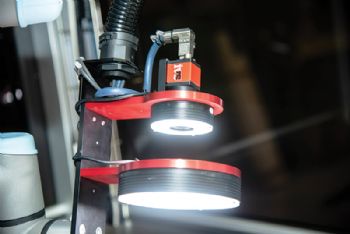
The Food and Drug Administration (FDA) has issued a ruling requiring that most medical devices distributed in the USA must carry a unique device identifier (UDI).
With the directive now in force it has become increasingly important for device manufacturers to put the necessary quality control procedures in place to confirm that the UDI is both
legible and traceable.
The FDA says: “A unique device identifier system has the potential to improve the quality of information in medical-device adverse-event reports, which will help the FDA identify product problems more quickly, better target recalls, and improve patient safety, with the UDI allowing the device or product to be traced back to its roots in manufacturing.”
This directive has implications for any manufacturer of electrical devices, and Didcot-based (Oxfordshire) Industrial Vision Systems Ltd (IVS —
www.industrialvision.co.uk) has been working with a number of companies to address the FDA’s requirements through the use of ever more advanced automated machine vision systems and processes.
When a UK medical manufacturer recently decided to automate the inspection of its part labels, it turned to IVS to build an automated label inspection system specifically for the purpose, including full validation to GAMP5 (Good Automated Manufacturing Practice) pharmaceutical regulations.
The system designed by IVS consisted of two digital vision systems (viewing two areas of the label) housed in a custom-designed stainless-steel housing mounted in front of the label-printing equipment.
The vision system communicates with the line PLC, printer and factory information system to confirm that the relevant part codes and lot codes match each other and are printed in a legible format.
The labels are indexed every second for inspection before being applied to boxes housing various medical devices.
Generic approach
The FDA demands that automatic identification and data capture (AIDC) technology is used for the inspection process. By combining Optical Character Recognition/Optical Character Verification with print quality inspection and ID/code reading, the labels are checked in real time through the whole production cycle to confirm compliance to the FDA specifications; and because a UDI can typically be applied to labels, boxes, products, components and devices, a generic approach to the quality inspection had to be developed.
The UDI directive also says all devices that will be implanted or sterilised must have permanent marks, so any vision inspection system must cope with verifying marks on a variety of material types, including implants.
Typically, a code includes a human-readable and a machine-readable mark, and both need to be inspected to confirm that they meet the necessary quality standards (for symbols, the ISO standards 15415 and 15416).
Digital cameras are used throughout the production process. These are connected to a central IVS vision system, which then communicates with the Factory Information System database to provide historical information and confirmation of conformance, as well as full track and trace, which is regarded as the ideal solution.
Indeed, most medical-device companies now run varied quality systems, data management and IT applications for their UDI requirements.
A flexible user interface allows data storage, image storage and historical statistical process control (SPC) data to be easily managed, independently of the background IT infrastructure.
Moreover, IVS says its latest-generation vision systems provide full audit logging and traceability to allow them to be validated to GAMP standards, adding that UDI quality can be tracked through the process to make sure that it has not degraded through the production cycle and that multiple elements (such as inserts and instructions) have gone together correctly.
“The UDI program will give consumers a better-quality product, increased traceability against forgery, and assurance that the product has been through the necessary production cycle and checks.
"In addition, the UDI program offers improvements in other industry sectors — most importantly, the food and
beverage industry, where date strings, price strings and livery quality are increasingly inspected in real time due to supermarkets’ ever-stricter requirements and government guidelines.